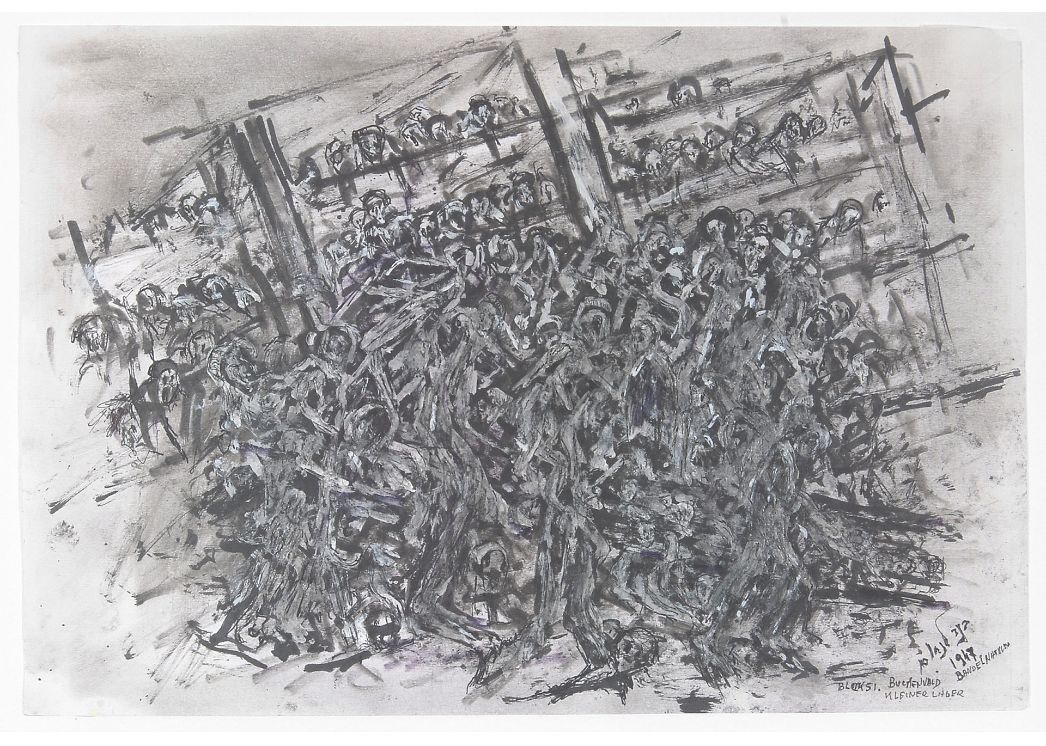
Two years after his liberation from the Buchenwald concentration camp, Nachum Bandel found his way of communicating what is “actually impossible to express”—he started drawing. Already a talented artist in his school days, in April 1947 he was one of a group of 26 young people in the British camp for Jewish immigrants on Cyprus who, under the tutelage of art professors from Jerusalem, compiled and printed a book of drawings about their new life. In his free time, he began exploring past experiences in the drawing medium: “I only drew my memories when I was alone, in the tent. I hardly had even a pencil, so I scratched the image on the paper.” That is how the drawing Block 51. Buchenwald. Little Camp came about. It depicts a mass of people in front of a wall of overcrowded bunk beds. It is virtually impossible to make out the individual figures. In the midst of the throng are people stumbling, falling, already fallen. Many of the human beings crowded together under these inhumane conditions did not survive the Little Camp. They did not even have the bare essentials for survival. Bandel had the solidarity of a political inmate, the Dutchman Hendrikus Bastiaanse, to thank for the fact that he was able to escape Block 51 and lived to witness the arrival of the U.S. Army on 11 April 1945.
Biography
Nachum Bandel, originally Nathán Bandel, was born to a Jewish family in Sevlus (present-day Vynohradiv, Ukraine) on 1 March 1928. He grew up in the Carpathian foothills and was sixteen when the German Wehrmacht occupied his home town in April 1944. He was deported first to the Mátészalka ghetto and then to Auschwitz, where his mother, his younger brother, and other members of the family were murdered immediately upon arrival. Just a few days later, on 6 June 1944, he himself was transferred to the Buchenwald concentration camp, and on 17 June from there to the BRABAG (Braunkohle-Benzin-Aktiengesellschaft) subcamp in Magdeburg-Rothensee. He returned to Buchenwald on 16 February 1945 in a state of utter physical debility. Hendrikus Bastiaanse of the inmates’ clothing depot detachment, saved his life by taking him out of the “Little Camp”, finding accommodations for him in an inmates’ barrack in the “Big Camp”, and caring for him until the liberation.
Bandel decided to emigrate to Palestine with a cousin. However, the “Theodor Herzl”, a cargo ship carrying several hundred Jewish refugees, was intercepted en route by warships of the British mandatory power and forced to land on the Mediterranean island of Cyprus. It was not until May 1948, after Cyprian internment for about a year, that he was finally able to enter Palestine. No sooner there than he fought in the War of Independence of the newly founded State of Israel. In 1950/51 he lived in the Kibbutz Neot Mordechai, where he met the woman he would later marry. He became the father of two sons and contributed to the country’s development by working at large-scale construction sites.
Little time remained for drawing, but Bandel never abandoned it. His themes were his childhood at the edge of the Carpathians, the Shoah, his new life in Israel. After his retirement in 1986, drawing and painting became his main focus. He exhibited in Israel on multiple occasions, for example in the Beit Chagall and the town hall of Haifa. In 1999 he opened an exhibition of his works entitled “Return to Life” at the Buchenwald Memorial. The show was then also presented in Magdeburg and Berlin. Nachum Bandel has been living in a suburb of Haifa for many years.


